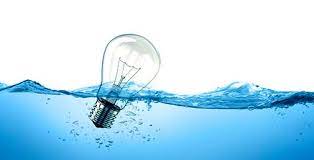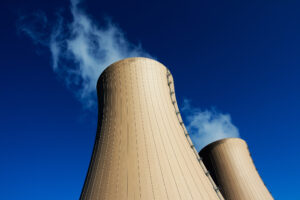Deionized water conductivity is a critical parameter when discussing the quality of water. It serves as a key indicator of purity and the absence of ions. In this article, you will learn more about this property, typical ranges, and specifications of deionized water.
What is Deionized Water?
Generally, water is a good conductor of electricity as it contains dissolved salts like anions and cations that allow electricity flow easily. However, to meet certain needs, it often undergoes purification processes such as mechanical filtration, distillation, and chemical treatment. All these processes alter the constituents of water in some way, but not as much as during deionization. The deionization process entails passing water through cationic and anionic-charged resins to filter inorganic impurities. In addition, these resins produce H+ and OH- ions that combine to create H2O. Although deionization is not effective in removing organic impurities, it is common to introduce charcoal filters and UV light in the process for more effective removal of these impurities. This technique is common in laboratories and industrial applications where the presence of ions in water can interfere with reactions, thus producing misleading results.
Why Measure Conductivity of Deionized Water?
As the previous section highlights, the goal of deionization of water is to purify it by removing all anions and cations. Because these charged ions are what make water a good conductor of electricity, it is safe to say that the fewer they are, the less conductive water is. This is why measuring conductivity is important, as it reveals the effectiveness of the deionization process. These measurements are common in several industrial applications, including:
- Laboratories: When carrying out sensitive experiments or manufacturing precision instruments, the use of deionized water helps to prevent skewed results or damage to equipment.
- Quality Control: In industries such as electronics and pharmaceuticals, purity is paramount, so monitoring deionized water conductivity is crucial. Any deviation from specified conductivity levels can indicate the presence of contaminants that will affect the quality of end products.
- Steam Power Plants: Utilizing deionized water for steam generation is an effective way to minimize scaling and corrosion. Such power plants deploy efficient monitoring systems to ensure that requirements for optimal steam quality are met to maintain equipment longevity.
Typical Range of Deionized Water Conductivity
Generally, the conductivity measurements of deionized water are either in microSiemens per centimeter (µS/cm) or megaohms per centimeter (MΩ/cm), depending on the industry and specific requirements. Because its value is temperature-dependent, the standard is to take measurements at 25℃. After deionizing water, values for conductivity should be ≤5.0 µS/cm, with lower values signifying greater levels of purity. Ultra-pure water, which serves in applications where even trace amounts of ions can compromise processes or products, has conductivity values below 0.1 µS/cm. Pure water, with conductivity between 0.1 and 1.0 µS/cm, is common in laboratories and other processes needing high purity but not with stringent standards as in ultra-pure water. While in manufacturing processes such as cooling systems, the need for purity is less, so conductivity ranges could be higher than 1.0 µS/cm. The higher the level of purity, the more the time and cost requirements.
Does Conductivity of Deionized Water Change?
Over time, the conductivity level of deionized water increases as water easily reacts with substances that come in contact with it. For example, when air comes in contact with deionized water, carbon dioxide dissolves in it. As a result, CO2 combines with the pure H2O to produce positively charged hydronium (H3O+) and negatively charged bicarbonate (OH–) ions.
2H2O+CO2H2O+H2CO3H3O++HCO3-
This is the reason why deionized water and water that has gone through other purification processes, such as distillation, can still corrode metals over time. The reaction produces carbonic acid, making the water slightly acidic. To avoid this change in conductivity, deionized water should be isolated from air and undergo continuous degassing. This process removes any dissolved gasses, such as carbon dioxide, and ensures that water remains pure.
Specifications of Deionized Water
There are several international and regional standards providing specifications for deionized water, with the ISO and ASTM being quite popular. According to ISO 3696, there are three grades of deionized water, which are grades 1 to 3, with grade 1 representing the purest form. The table below highlights the specifications for each grade.
| Parameter | Grade 1 | Grade 2 | Grade 3 |
| Conductivity (µS/cm) at 25℃ | <0.1 | <1.0 | <5.0 |
| pH at 25℃ | – | – | 5.0 – 7.0 |
| Oxygen content (mg/L), max | – | <0.08 | <0.4 |
| Residue after evaporation, on heating to 110℃ (mg/kg), max | – | <1 | <2 |
| Silica content (mg/L), max | <0.01 | <0.02 | – |
The ASTM D1193-06 classifies deionized water into four grades with Type I having the highest purity level.
| Parameter | Type I | Type II | Type III | Type IV |
| Conductivity (µS/cm) at 25℃ | <0.056 | <0.25 | <1.0 | <5.0 |
| Resistivity (MΩ-cm) | >18.0 | >4.0 | >1.0 | >0.2 |
| pH at 25℃ | – | – | – | 5.0 – 8.0 |
| Total Organic Carbon (ppb or µg/L) | <50.0 | <50.0 | <200.0 | – |
| Sodium (ppb or µg/L) | <1.0 | <5.0 | <10.0 | <50.0 |
| Chlorine (ppb or µg/L) | <1.0 | <5.0 | <10.0 | <50.0 |
| Silica (ppb or µg/L) | <3.0 | <3.0 | <500.0 | – |
Conclusion
Deionized water conductivity stands as a beacon of purity in various industries where water quality is non-negotiable. From pumping ultra-pure water through a network of pipes and valves to general applications requiring high-quality water, understanding and controlling conductivity levels are paramount. As technologies advance and industries demand even greater levels of purity, the meticulous management of deionized water conductivity will continue to be a cornerstone in ensuring the integrity and success of diverse industrial processes.




